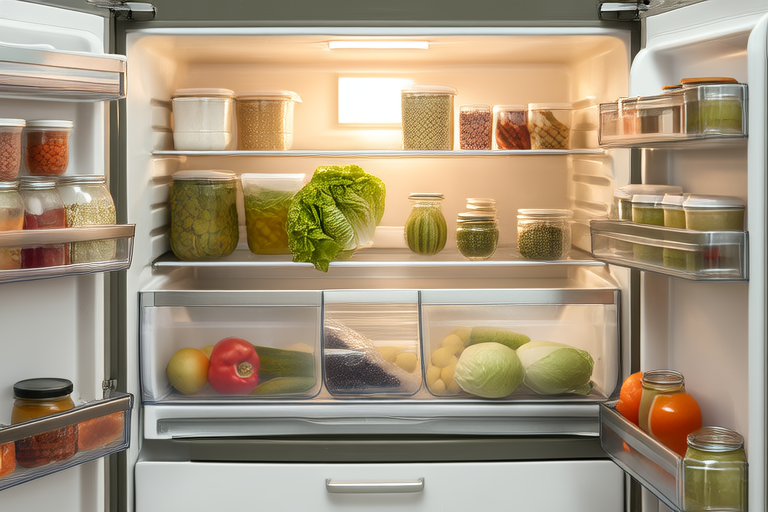The Importance of Proper Food Storage
Food waste is a significant global issue, contributing to environmental degradation and economic inefficiency. In the United States alone, approximately 30-40% of the food supply goes to waste each year. A major factor in this waste is improper food storage. By understanding common mistakes in food storage, we can significantly reduce waste and save money. This article will explore some of the most frequent errors people make when storing food, offering practical solutions to keep your groceries fresh for longer.
Mistake 1: Storing All Fruits Together
One of the most common mistakes is storing all fruits together. Many fruits release ethylene gas, which accelerates ripening. When stored with other fruits or vegetables, ethylene-sensitive items like leafy greens or carrots can spoil prematurely.
Ethylene Gas Producers vs. Ethylene-Sensitive Foods
Ethylene gas producers include apples, bananas, avocados, peaches, and tomatoes. These fruits should be kept separate from ethylene-sensitive foods like berries, broccoli, cucumbers, and peppers. For example, placing an apple next to a bunch of bananas will cause them to ripen faster, potentially leading to waste if you don’t use them quickly enough.
Practical Tip: Create Zones in Your Refrigerator
To avoid this issue, create distinct zones in your refrigerator for ethylene producers and ethylene-sensitive foods. Use crisper drawers for vegetables and store fruits in the main compartment. You can also place ethylene-sensitive fruits in perforated plastic bags to slow down the ripening process.
Mistake 2: Improper Use of Crisper Drawers
Many people assume that crisper drawers are just for keeping vegetables fresh. However, these drawers have humidity settings that can drastically affect the shelf life of your produce. Understanding how to use them properly can extend the freshness of your food.
High Humidity vs. Low Humidity Settings
Most refrigerators come with adjustable crisper drawers. High humidity settings are ideal for leafy greens and herbs, as they need more moisture to stay crisp. Conversely, low humidity settings are better for fruits and vegetables that are prone to rotting, such as apples, pears, and root vegetables like carrots and potatoes.
Practical Tip: Label Your Crispers
Labeling your crisper drawers can help you remember which setting is best for different types of produce. This simple step can prevent confusion and ensure that your food stays fresh longer.
Mistake 3: Storing Bread in the Refrigerator
Another frequent mistake is storing bread in the refrigerator. While refrigeration can extend the shelf life of many foods, it has the opposite effect on bread. The cold temperature causes bread to dry out faster, making it stale sooner.
Why Cold Temperatures Affect Bread Differently
Bread contains moisture, and refrigeration draws this moisture out, causing the bread to become hard and less palatable. Instead of refrigerating bread, it’s better to store it at room temperature in a bread box or tightly sealed container.
Practical Tip: Freeze Bread for Long-Term Storage
If you won’t be using your bread immediately, consider freezing it. Wrap the bread tightly in plastic wrap or aluminum foil before placing it in a freezer bag. Thawed bread will still be fresh and delicious.
Mistake 4: Overcrowding the Freezer
Freezers are often used as long-term storage solutions, but overcrowding them can lead to inefficiencies. When items are packed too closely together, cold air cannot circulate properly, which can result in uneven freezing and potential spoilage.
Proper Freezing Techniques
To maximize efficiency, ensure that items have adequate space to freeze. Leave some room between packages so that cold air can circulate freely. Additionally, use airtight containers or freezer-safe bags to protect food from freezer burn.
Practical Tip: Organize Your Freezer
Organizing your freezer can make it easier to find what you need and ensure that nothing gets forgotten. Use clear labels and date items when you freeze them. This way, you can rotate older items to the front and use them before they expire.
Mistake 5: Misunderstanding Expiration Dates
Many people rely solely on expiration dates when determining whether food is safe to eat. However, these dates are often misleading and can lead to unnecessary waste. Understanding the difference between “best by” and “use by” dates can help you make more informed decisions about your food.
The Meaning Behind Expiration Dates
“Best by” dates indicate the peak quality of the product, while “use by” dates suggest when the product may no longer be safe to consume. In reality, many foods remain edible well past their “best by” dates. For example, eggs can last up to five weeks beyond their sell-by date if stored properly.
Practical Tip: Smell and Look for Signs of Spoilage
Instead of relying solely on expiration dates, check for signs of spoilage. Smell and visually inspect food before discarding it. If it looks or smells off, it’s best to err on the side of caution.
Case Study: Reducing Food Waste at Home
To illustrate the impact of proper food storage, let’s look at a real-world scenario. Sarah, a busy professional, was frustrated by the amount of food she wasted each month. She decided to implement some of the strategies mentioned above. By separating fruits and vegetables, organizing her crisper drawers, and freezing excess bread, Sarah noticed a significant reduction in her food waste. Over six months, she saved over $200 on groceries and reduced her household waste by nearly 50%.
Conclusion: Taking Action to Reduce Food Waste
Proper food storage is crucial in reducing waste and saving money. By avoiding common mistakes like storing all fruits together, misusing crisper drawers, and misunderstanding expiration dates, you can extend the shelf life of your groceries. Implementing these tips not only benefits your wallet but also contributes to a more sustainable planet. Start by assessing your current storage habits and making small adjustments. With time, these changes will become second nature, helping you minimize waste and enjoy fresher, healthier meals.
